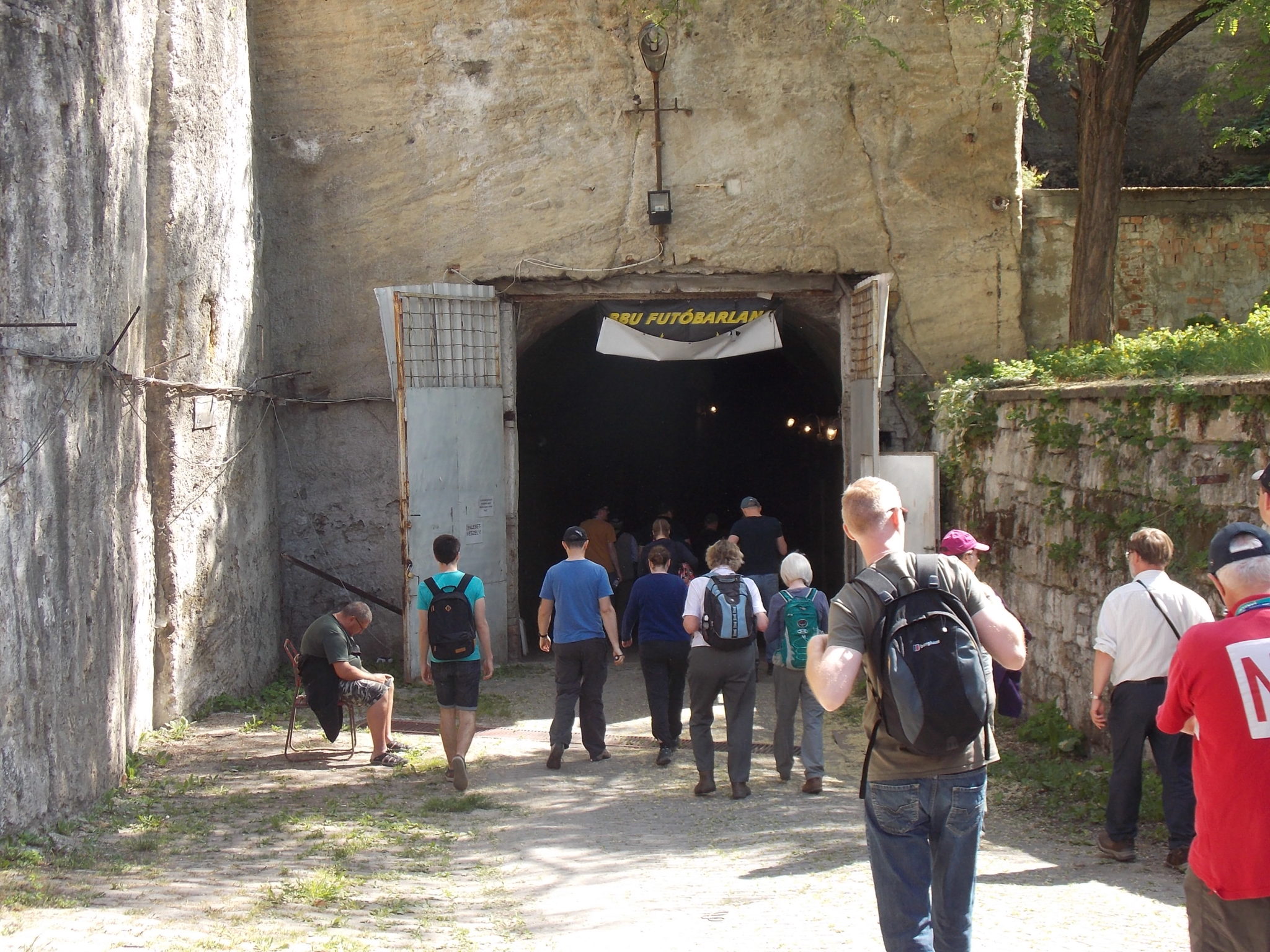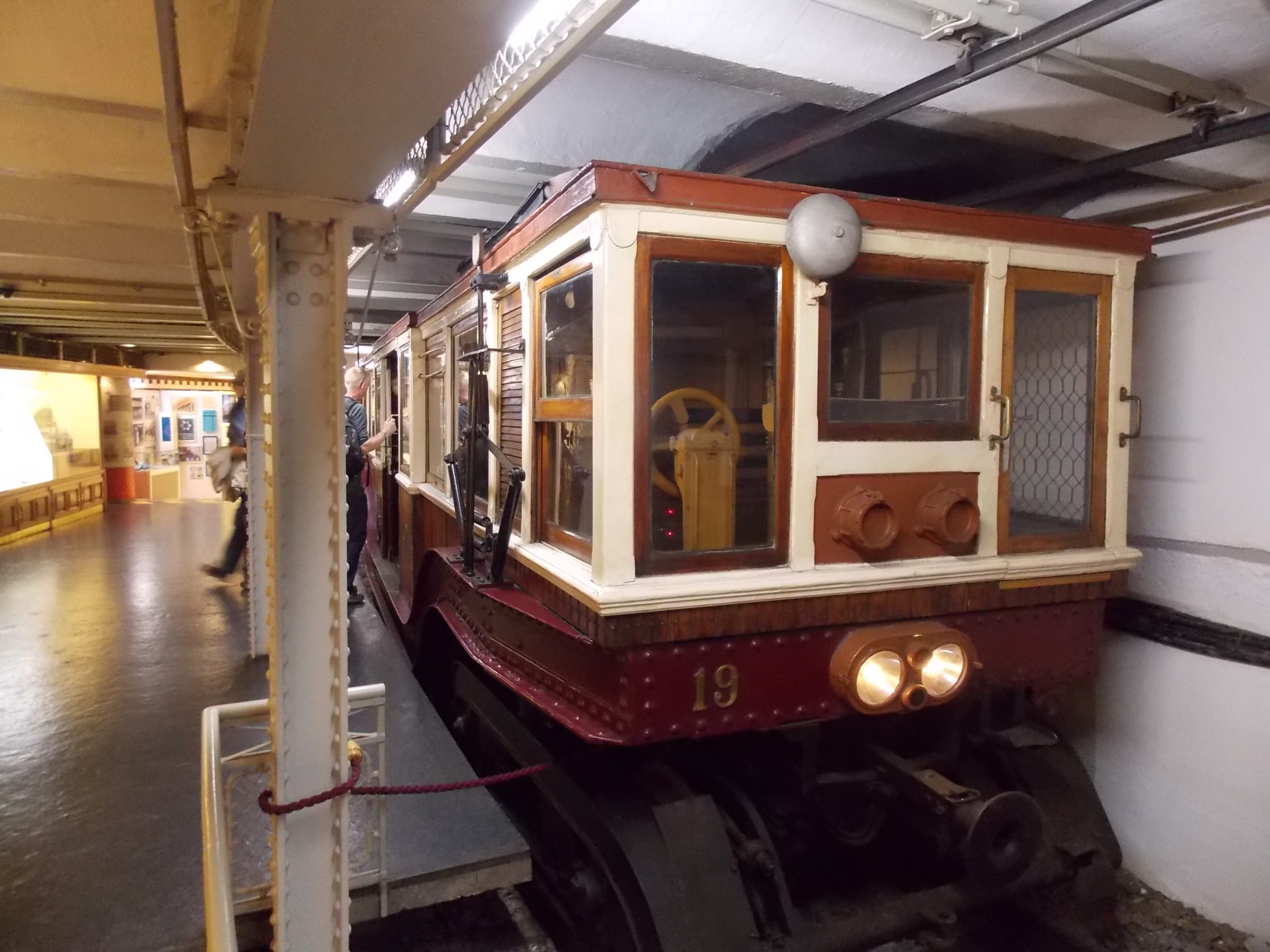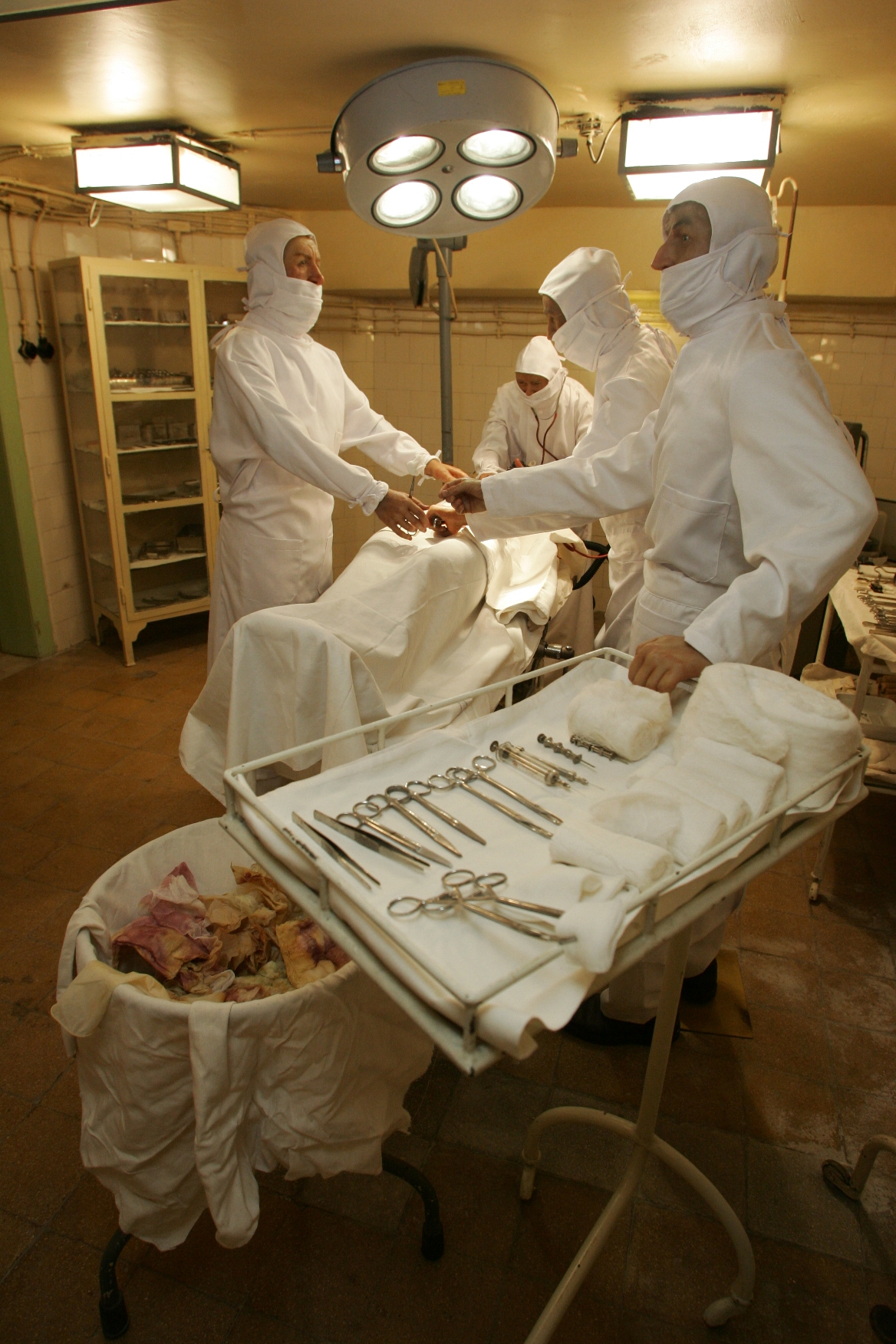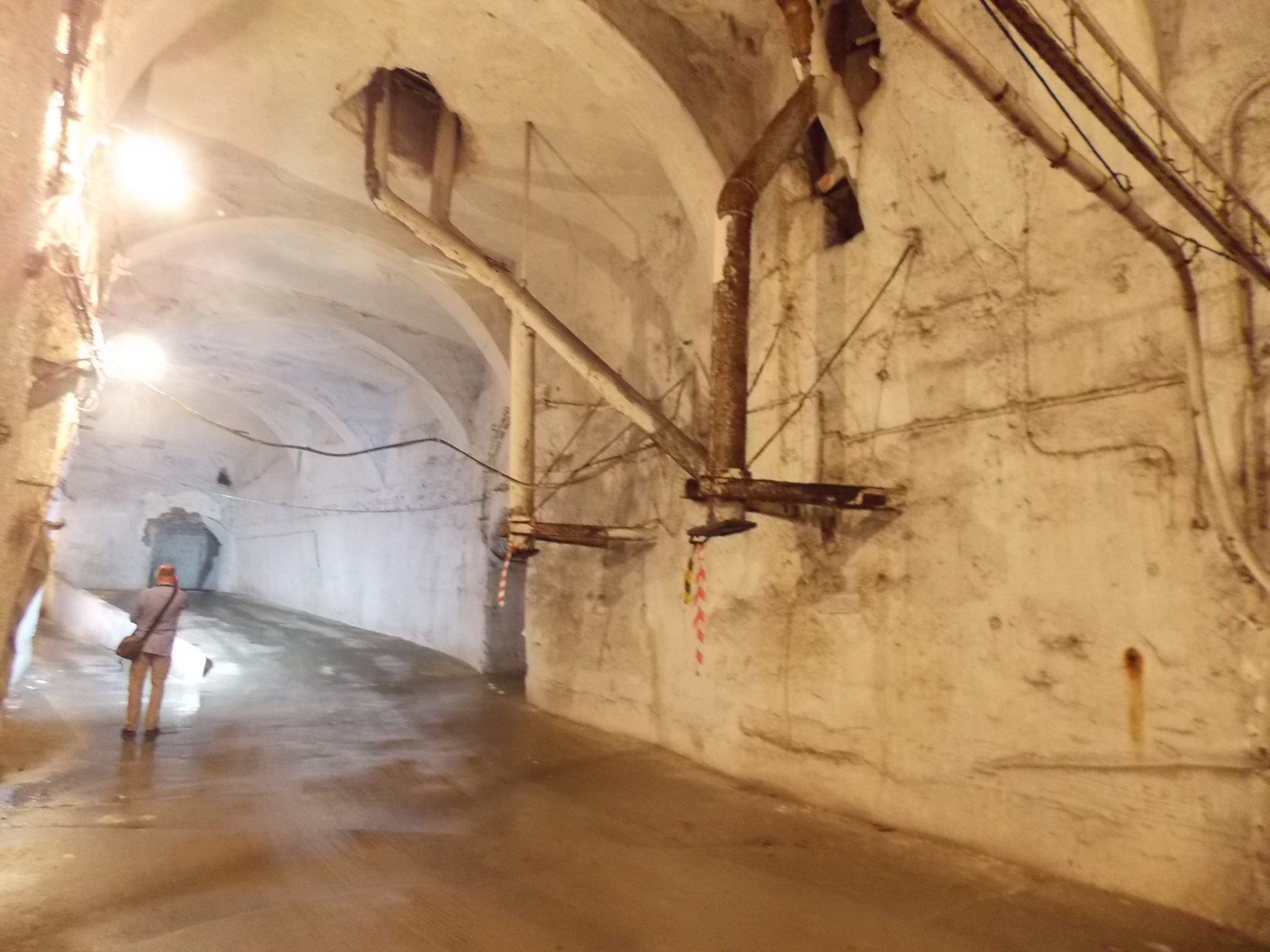
Subterranea Britannica group enters the Kőbánya cellar system, 35 kilometres of underground quarry. Photo: Peter Burgess
I was once an active member of Subterranea Britannica, usually abbreviated to “Sub Brit”. Its quirky interest in man-made and man-used subterranean space appealed to me, and my own interests in old mine and quarry workings fitted in well. After I allowed my full membership to lapse some 20 years ago, and simply became the exchange member for my club, I maintained many friendships and never entirely lost touch with the group. I followed their exploits and interests through the excellent publication “Subterranea”. Early in 2018 I was approached by the Sub Brit chairman Martin Dixon about the upcoming Study Weekend to be held in Budapest in May. With my two sons living in the city, it would clearly be much easier for him to organise the event utilising their bilingual skills. The additional benefit at the weekend of having a couple of translators interested in subterranean things was an obvious added bonus!
The lads were more than happy to get involved, after all, it would provide free access to some fascinating sites not normally accessible, and they would be fed and watered for nothing for two days, a definite bonus for students. Martin warned them that they would be spending two days with 40 people “as old as your dad”, as if that was going to be a problem!
Hungarian Translation by Dominik Burgess.
Én még valamikor egy aktív tagja voltam a Subterranea Britannica csoportnak, (röviden Sub Brit). Tetszett nekem az érdeklődésük az emberi készítésű vagy használatú földalatti terek után, saját érdeklődésem régi bányák után is jól illett hozzá. Miután tagságom elmúlt körülbelül húsz éve, én lettem a saját klubbunknak a „cseretagja”. Sok baratságot fenntatrottam és nem vesztettem el teljesen a kapcsolatot a csoporttal. Követtem őket a nagyszerű publikációjukon, a „Subterranea”-án keresztül. Kora 2018-ban a csoport elnöke – Martin Dixon – megközelített a közeledő tanulmányi hétvégével kapcsolatban, amely Budapesten fog helyet foglalni májusban. Mivel két fiam a fővárosban lakik, egyértelműen könnyebb lenne neki az eseményt megrendezni a kettős anyanyelvi tudásuk felhasználásával. További egyértelmű előnye volt, hogy a hétvégén lenne egy pár fordítani tudó, akiket szintén érdekelnek a föld alatti dolgok.
A fiúk boldogan részt vettek, hiszen ingyenes belépést biztosított néhány elbűvölő helyre – melyek normális körülmények között el vannak zárva – valamint vacsorát is kaphatnak, ami két diáknak önmagában is öröm. Martin figyelmeztette őket, hogy negyven olyan idős emberrel fognak eltölteni két napot, mint az apjuk, mintha ez nagy baj lenne!
Some of the sites visited were tourist attractions normally open to the public, and others required special permission to arrange a visit and to provide a guide. The timetable for the weekend was only finalised in the last few days as confirmation for a major visit to the Kőbánya stone quarry on Sunday only came through at the last minute.
Although there were a good number of places to visit, there was always enough time to get from location to location, without much risk of running late and upsetting the numerous guides and hosts that had agreed to meet us. Saturday was entirely composed of publicly accessible locations, and all the moving from place to place was by public transport – metro, trams, and buses.
Néhány meglátogatott hely turista-látványosság volt, melyek mindenki számára nyitottak, a többihez külön kellett engedélyt kérni a belépéshez, valamint, hogy biztosítva legyen egy idegenvezető. A hétvége rendje csak az utolsó pár napban lett véglegesítve, mivel a vasárnapi kőbányai látogatást csak az utolsó percben sikerült elintézni.
Jó számban voltak látogatnivalók és mindig volt elég idő a helyszínek közti utazásra, anélkül, hogy aggódni kéne attól, hogy elkésünk. Szombaton csak mindenki számára látogatható helyeket néztünk meg, és minden utazás a helyszínek között tömegközlekedéssel történt, metróval, villamossal és busszal.
With Sub Brit’s remit to visit and study any man-made or man-used underground space, the scope for suitable locations is pretty wide in any major city. Consequently, following a short visit to a church built into a cave in a cliff face at Sziklatemplom, in which a church service started while we were there, a ride on the driverless M4 metro line took us to the grandest of the three main line railway termini of Budapest, Keleti pályaudvar, from which a walk took us to Kerepesi cemetery. Well, it is man-used underground space of a sort, if a little macabre.
More information on Sziklatemplom.
The Kerepesi cemetery is perhaps, in a tenuous way, Hungary’s equivalent of Westminster Abbey, where the nation’s famous people are interred and memorialised. Coincidentally, the day we visited was also a special day on which a number of the mausoleums were opened up for visitors to enter and appreciate. The grandeur of some of the tombs was awe-inspiring, with wonderful use of marbles, and mosaic decorations to admire.
Elég tág a Sub Brit számára megfelelő helyszínek hatásköre, mivel bármilyen föld alatti tér megfelel. Következésképpen, a sziklatemplomba való rövid látogatás után a vezető nélküli 4-es metró vitt minket a legnagyobb pályaudvarra Budapesten, a Keletibe, ahonnan egy rövid séta vitt minket a Kerepesi temetőbe – amely ha úgy nézzük egy ember által használt föld alatti tér, még ha ez egy kicsit kísérteties is.
A Kerepesi temető valamilyen szinten összehasonlítható a londoni Westminster Abbey-hoz, ahol az ország híres emberei vannak eltemetve.Véletlen egybeesés volt, hogy a napon amikor meglátogattuk, pont nyitva volt néhány mauzóleum a látogatók számára. Néhány síremlék nagyszerűsége hihetetlen volt, csodálatosan használták fel a márványt és rengeteg mozaikban lehetett gyönyörködni.

Budapest is home to continental Europe’s oldest underground railway, which although included in a World Heritage site is still part of the normal public transport network, and is designated the M1 route. A short ride on the line was therefore in order, as well as a visit to the small museum where some of the original M1 stock has been preserved. These cars were still in use in the 1970s.
Budapest az otthona a kontinentális Európa legrégebbi föld alatti vasútjának, amely a világörökség része, mégis a mindennapi tömegközlekedés hálózatának része. Így egy-két megállót kellett menni az egyes metrón, és meg kellett látogatni a kis múzeumot, ahol az eredeti egyes metró kocsijai megmaradtak. Ezek a kocsik a 70-es évekig használatban voltak.

More information on the Millenium Underground Museum.
The last site to be visited on Saturday was Sziklakórház Atombunker Múzeum, or the “Hospital in the Rock”. This originated as a set of natural cavities in the limestone, which were adapted as rock-cut cellars under the old city, and later joined together into a safe space in the 1930s in preparation for the anticipated hostilities. It was equipped as a hospital to cope with the casualties of air-raids, and was used in 1944 when the Allied forces bombed the city, and again in 1945 when the Soviet Red Army encircled German forces in the Siege of Budapest which lasted 100 days. The bunker again saw active use in 1956 during the Hungarian civilian uprising, with both Soviet and revolutionary casualties being treated. The last repurposing of the bunker was as a Cold War civil defence shelter which only ceased in 2004. The tunnels reopened as a museum in 2008.
The museum has also set up an exhibition on the dreadful effects of nuclear weapons, with a number of objects recovered from Hiroshima. Some of the more gruesome photos are only viewable through peepholes at adult eye-level.
Public tours of the bunker are possible on most days of the year, with tours led at different times by guides speaking either English or Hungarian. A visit is highly recommended.
Az utolsó helyszín amit meglátogattunk szombaton a Sziklakórház Atombunker Múzeum volt. Eredetileg természetes mészkőbarlangként kezdték itt az alagutak, melyeket kihasználtak pinceként a vár alatt. A 30-as években összekötötték őket egy biztonságos térré a várható ellenségeskedések elől. Felszerelték kórházként, hogy megbírkózzon a légitámadások áldozataival 1944-ben amikor a szövetségesek bombázták a várost, valamint 1945-ben újra, amikor a szovjet vöröshadsereg körülvette a német erőket Budapest ostromában amelyek 100 napig tartottak. A bunker ismét használatba került 1956-ban a forradalom idején, amikor magyar és szovjet áldozatokat is elláttak a kórházban. A bunker utoljára a hidegháború idején lett renoválva, egy civil védelmi menedékhelyként, amely csak 2004-ben szűnt meg. Az alagutak 2008-ban nyíltak meg múzeumként, és azóta sok újítást látott a múzeum.
A múzeum kiállítást is készített az atomfegyverek borzasztó hatásairól, néhány tárggyal a hiroshimai robbanás helyszínéről. Pát képet csak egy apró résen keresztül lehet megtekinteni, melyek felnőtt szemmagasságban vannak.
A bunkertaz év majdnem összes napján meg lehet látogatni, az idegenvezetők beszélnek angolul és természetesen magyarul. A látogatása nagyon ajánlott.

More information on Sziklakorhaz Museum.
Sunday was entirely devoted to sites specially opened for the group. For more than twenty years, I have been aware that the Kőbánya district that I passed through to and from the city airport was built over an underground stone quarry. Kőbánya translates exactly as “stone quarry”. The complex is owned by the Kőbánya local authority, which provides guides, and our visit was with the special permission of mayor Róbert Kovács. The local authority conducts tours of the site by special arrangement throughout the year, and the quarry is also home to cave diving activities, and civic events such as running competitions.
The site has a long and varied history of stone extraction, and subsequent re-use. It provided building materials for many of the historic buildings and architectural features of Budapest, and elsewhere. The quarry worked an Eocene limestone of a pale cream colour. Quarrying ceased after an unfortunate fatal accident in 1890 and the galleries then took on new uses. First, local wine growers used them as wine cellars. The area was once rural and covered in vineyards. When the city grew and the area above the quarry was developed, Antal Dreher the famous Austrian brewer set up a lager brewery at the caves where the constant cold temperature proved to be ideal for processing and storing malt. More recently, there was also a period of mushroom growing using large trays, but this has now ceased. One part of the quarry contained a liqueur distillery, but our guide did not know which particular product was made there.
Vasárnapon kizárólag a csoportnak külön megnyitott helyszíneket látógattunk meg. Több mint húsz éve tudtam arról, hogy kőbányai kerület – ahol átutazok a városból a reptérre menet – egy bányára épült. A komplexum a kőbányai önkormányzat tulajdonában van, akik biztosítanak idegenvezetőt. Látogatásunk Kovács Róbert külön engedélyével történt meg. Az önkormányzat az év során különleges rendezvényeket illetve túrákat szervez – pédául futóversenyek – és a bánya otthont ad föld alatti búvárkodási tevékenységeknek is.
A helyszínnek hosszú és változatos története van a kő kitermeléssel, majd a későbbi újrafelhasználással kapcsolatban. Alapanyagot biztosított Budapest számos történelmi épületének és építészeti jellegzetességeinek, és még sok más helyen is. A kőfejtő egy halvány krémszínű eocén mészkővel dolgozott. A kőfejtés egy 1980-ban történt halálos balaset után megszűnt, és az alagutak másra lettek felhasználva. Eleinte a helyi borászok pincékként használták őket. A terület egyszer vidéken volt, és szőlőültetvények borították. Amikor a város kiterjedt és a bánya fölötti területen már város alakult, Dreher Antal a híres osztrák sörfőző telepített egy sörfőzdét a barlangokban, ahol az állandó hideg hőmérséklet ideálisnak bizonyult a malát feldolgozásához és tárolásához. A közelmúltban gombatermesztés is volt a bányában, de ez mostmár megszűnt. A kőfejtő egy része tömény szesz desztillálást folytatott, de az idegenvezetőnk nem tudta, hogy pontosan mit készítettek ott.

Remains in the malt processing area of Antal Dreher’s brewery, Kőbánya cellar system. Photo: Peter Burgess
Large underground spaces in Europe were often adapted for wartime uses, and this site was no exception. It was converted into an underground factory during the Second World War for the assembly of Messerschmitt Bf 109 fighter plane components, which was vacated when the Red Army advanced into Hungary, and the galleries were then available as shelters for civilians when Allied bombing commenced, and when the Red Army subsequently swept through.
I believe we walked through 1.5 km of the 35 km of galleries that are known to exist. A significant area of the lower part of the quarry is now flooded and provides a good training area for cave diving.
Európában a nagy föld alatti tereket gyakran alkalmazták háború alatt, és ez a hely sem volt kivétel. A második világháború alatt a Messerschmitt Bf 109 harci repülőgép alkotóelemeit itt készítették, melyet kiürítettek a vörös hadsereg Magyarországra való betörését követően. A galériák menedékként szolgáltak a civilek számára amikor a szövetéges bombázás megkezdődött, és amikor a vörös hadsereg később áthaladt.
Úgy tudom, hogy a 35 kilóméteres alagútrendszer másfél kilóméteres körútján mentünk végig. A bánya jelentős része el van áradva, és jó gyakorlóhelyet biztosít a búvároknak.
More information on the Kőbánya Cellar System.
The afternoon was spent in the semi-industrial district of Csepel. First, we were taken to a pleasant residential area to the south of the district, where a Second World War shelter had been converted into a Cold War period shelter, which had been restored in 2016 on the 60th anniversary of the Hungarian uprising. Csepel was the district where the 1956 revolutionaries held their last stand, before the Soviet forces succeeded in crushing the rebellion. In the United Kingdom, much of what was reported took second stage to news of the Suez Crisis which was happening at the same time.
The shelter, in Tamariska Park, was constructed using precast elliptical concrete sections, and the sandy ground in which they were positioned was moved using water jets. How they removed the resulting slurry was not explained. The original 1940s shelter was lined with bricks, and only one small section is accessible. The rest was converted in the 1950s and is accessible, or has been sealed off with a steel door as it has collapsed. Displays in the shelter focus on the 1956 uprising with photos and explanations of how the conflict developed and how it was put down.
A délutánt Csepel félig-meddig ipari körzetében töltöttük. Először egy kellemes lakónegyedbe mentünk a kerület déli részén, ahol egy második világháborús menedékhelyet átalakították a hidegháborúban. 2016-ban az 1956-os forradalom évfordulóján állították helyre. Csepel volt az utolsó kerület a fővárosban ahol a szovjet erők legyűrték a forradalmat. Angliában nem keltett nagy hírt a forradalom, mely a suezi válság mellett eltörpült.
A Tamariska parkban lévő bunkert előre elkészített parabolikus beton szakaszok segítségével építették fel. A homokos talajt amelyben elhelyezték, vízsugarakkal mozgatták el. Az eredeti 40-es évekbeli menedék téglával van borítva és csak egy apró része elérhető. A többi részét az 50-es években átalakították és még elérhető, vagy el lett zárva egy vas ajtóval, mert beomlott. A néhány kiállított tárgy a bunkerban az 56-os forradalomra fókuszál, magyarázatokkal, hogy hogyan alakult a konfliktus.

More information on the Tamariska Park shelter.
Video of the Tamariska Park before restoration (in Hungarian).
Our next site was a short coach ride away, and is located under a school in the south-west part of Csepel. This was built in 1960 as a local government emergency control centre, during the Cold War. All other districts of Budapest have got rid of their bunkers, except Csepel, where it has been preserved just as it was when it was closed, and is now available as an educational resource explaining the fears of Western attack, and the civil defence counter-measures that were put in place in Hungary. The original plant is still in place, and most of the original fixtures and fittings. One of the guides took great pleasure in showing us a small metal box which on opening revealed a tiny coffee “espresso” pot and burner, for preparing the coffee ration for anyone holed up in the shelter! The entire bunker is a museum of genuine period items and mainly the result of the dedication and hard work of one man, 82 years old József Babán. József was later revealed by his assistant to have been a member of the Hungarian Winter Olympics ice-hockey team in 1964, the games being held in Innsbruck. A rousing “three cheers” for our hosts concluded our tour of the bunker, and we moved on to our last site of the weekend.
Etkező helyszín egy rövid buszozás után Csepel délnyugati részén elhelyezkedő iskola alatt található. Ezt 1960-ban építették fel, mint helyi kormányzati vészhelyzeti központot a hidegháború idején. A többi budapesti kerület megszabadult a bunkereiktől, kivéve a Csepelt, ahol ugyanúgy meg van őrizve, mint amikor bezárult, és jelenleg oktatási erőforrásként is elérhető, amely elmagyarázza a nyugati támadással kapcsolatos félelmeket és a Magyarországon bevezetett civil védelmi intézkedéseket. A eredeti üzem továbbra is a helyén van, az eredeti szerelvényekkel. Az egyik vezető – egy hölgy aki vigyáz a bunkerra – örömmel mutatta meg a fémdobozban tárolt espresso főzőjét, a bunkerban lévő személyek kávéadagjának elkészítésére.
Az egész bunker egy valódi korabeli tárgyakkal teli múzeum, és elsősorban egy ember, 82 éves Babán József elkötelezettsége és kemény munkájának köszönhető. Józsefről később kiderült feleségének köszönhetően, hogy tagja volt a magyar jégkorong csapatnak, és 1964-ben kijutottak az innsbrucki téli olimpiára. A felbuzgó angol szokás, a „három éljenzés”-el zárta le a bunker látogatását és továbbmentünk a hétvége utolsó helyszínére.

More information on the Csepel control centre (in Hungarian) and photos.
Also in Csepel, our last site was a Second World War air raid shelter right in the heart of the older industrial section, surrounded by semi-derelict factories and small business units. Unlike their subterranean equivalents in Britain, the seventeen shelters in the industrial heart of Csepel were located on the surface, and were in effect huge cast blocks of concrete with rooms within for sheltering workers. We visited two of the sixteen surviving structures. The first, shelter 2, has been set up as a small private museum by our guide, Levente Somogyi. Levi spoke good English and was very knowledgeable. He is keen to capture the memories of surviving men and women who sheltered in the bunkers in 1945. To achieve this, he has posted notices around the district, and has so far been in touch with a dozen or so elderly people, and produced video recordings of their recollections.
Following our visit to the museum shelter, we were allowed to see one extra site close by. This was a much larger shelter originally run on the same principle for nearby factory workers, but now empty of all period features and used as a music and entertainment venue. We were allowed to climb the stairs within the shelter, but each room was locked, one with something noisy going on within! The first thing I noticed on entering the bunker was the smell of something “herbal”. We didn’t ask.
Video of the shelters produced by Levente (in Hungarian):
Csepelen volt az utolsó helyszín is, a régi ipari részleg szívében, egy második világbáborús légi menedékhely, mely félig működő gyárakkal és kisvállalkozásokkal volt körülvéve. Az Angliában található föld alatti ekvivalenseivel ellentétben a Csepelen található tizenhét menhely a felszínen található. Hatalmas öntött beton blokkok voltak, amelyek a dolgozók védelmét szolgálták. A tizenhat fennmaradt epítményből kettőt néztünk meg. Az első menedék – a kettes számú – kis múzeumként lett felszerelve a vezetőnk, Somogyi Levente által. Levi jól beszélt angolul és sok tudása volt a menedékekkel kapcsolatban. Megszeretné örökíteni a túlélők emlékeit akik 1945-ben a bunkerban kerestek menedéket. Ennek érdekében hirdetéseket tett fel a kerületben, és eddig körülbelül egy tucat időskorú emberrel volt kapcsolatban, akikről készített egy videót ahogy elmesélik történeteiket.
A múzeum menedék meglátogatása után még egy további helyszínt tudtunk megnézni a közelben. Ez egy sokkal nagyobb menedék volt, amely azonos céllal lett felépítve a szomszédos gyárak munkásainak. Ez a bunker semmilyen korabeli tárggyal nem rendelkezik már, helyette zene és szórakoztatás helysíne lett. A menedéken belül a lepcsőhézban közlekedhettünk csak, mivel az összes ajtó be volt zárva. Az egyik ajtó mögött nagy volt a hangzavar. Az első dolog amit a bunkerbe való belépéskor észrevettem, valamiéyen “gyógynövény” illata volt. Inkább nem kérdeztüönk semmit.
A buffet dinner at the Hotel Budapest completed a very pleasant and informative weekend. Congratulations to those who organised the weekend, Martin and Linda Dixon, and Tony Radstone, and to those who provided assistance.
Subterranea Britannica is a large group established in 1974, which brings together a wide range of interests, and promotes the study of places which might otherwise not receive the attentions of cavers, mine-historians, archaeologists or social historians. Membership is open to anyone, and members get access to an online forum, receive three copies of the journal “Subterranea” each year, and are encouraged to arrange and join group visits to a variety of sites and areas both within Britain and further afield. Sub Brit’s Facebook and Twitter pages are open to all.
More information about Subterranea Britannica.
A Hotel Budapestben egy svédasztalos vacsora hozta el a nagyon kellemes és informatív hétvége végét. Gratulálok azoknak akik megrendezték a hétvégét, Martin és Linda Dixon, Tony Radstone, és mindenki más aki segítséget nyújtott.
A Subterranea Brittanica 1974-ben létrejött csoport, amely széles érdeklődési körrel rendelkezik, és elősegíti azon helyek tanulmányozását, amelyek egyébként nem foglalkoztatják a barlangászokat, bányatörténészeket, régészeket vagy társadalmtörténészeket. A tagság mindenki száméra nyitott, és a tagok hozzáférést kapnak egy online fórumhoz, évi három példányban kapják meg a „Subterranea” folyóiratot, és arra ösztönzik őket, hogy csoportos látogatásokon vegyenek részt mind Angliában, mind pedig máshol a világban. A Sub Brit Facebook és Twitter oldalai mindenkinek nyitva állnak.
